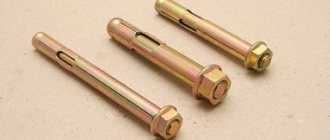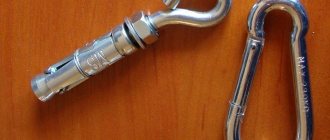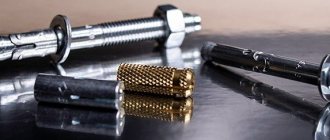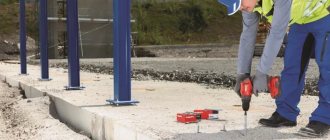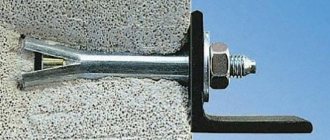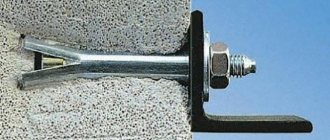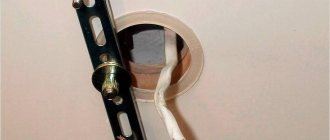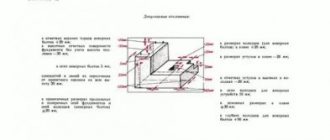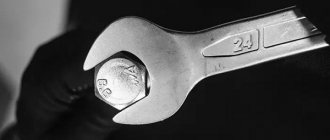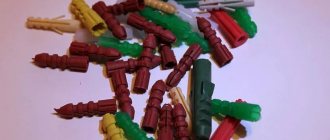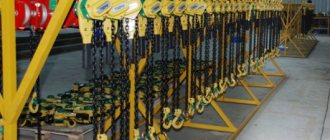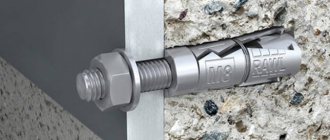Useful information about the practical use of a wedge anchor - one of the most reliable hardware for fixing heavy objects on concrete surfaces.
The wedge anchor for concrete has the best holding capacity among mechanical type expansion fasteners, which allows it to be used for heavy and medium loads. It consists of a threaded stud at one end and a spacer at the other. The fastener comes with a nut and washer. When the nut is tightened, the tapered shank is pulled into the collet sleeve, wedging it apart and thereby ensuring rigid fixation in the hole.
How does an anchor fastener with a nut work?
Taking into account the fact that this fastening mechanism must hold quite heavy elements, it was carefully thought out and redesigned. The main structural element in it is a spacer pin, which has a cone shape at one end, and a metric thread is cut at the other end, onto which a nut is screwed. The entire length of the stud, except for the threaded part, is fitted with a special metal sleeve with slots.
This device works on the principle of “expansion”, that is, when we start to tighten the nut, the cone-shaped end enters the sleeve and expands it in the hole. A distinctive feature is that such an anchor has a cast pin, which is much stronger than other anchor structures. Well, and, of course, we forgot to mention the nut and, without fail, the lock washer, which are screwed on from the thread side. The washer does not allow the nut to go deeper into the hole when tightening.
In some cases, during fastening, installers use a second washer as an additional lock, which closes the hole at the installation site, but this approach depends on the specific installation conditions. The scope of application of such fasteners can be quite different: from the installation of stair railings to heavy metal structures. The most popular application today is the installation of brackets for air conditioning. The device itself has quite a decent weight, so the use of such a mount is completely justified.
Wedge anchor
It is a special wedge nut installed inside the hole, with a sleeve installed on top. When the bolt is tightened, the nut, trying to come out, wedges the sleeve and is firmly held inside the hole.
This design is a bushing with a conical hole inside and a thread. When screwing in the anchor, the sleeve wedges into the hole and is thus fixed.
Expandable butterfly anchor. The main feature is that it can be installed in through holes, as well as in the case of thin-walled bases. The principle of operation is based on the deformation of the middle part and the opening of the petals when screwing in the anchor.
Expansion anchors. This is the most common type and does not require particularly careful adherence to the hole dimensions. The principle of operation is based on the expansion of the bushing when a pin with a cone-shaped or spherical thickening at the end is pulled out of it during the process of screwing a nut onto it and pulling it out.
So, we have indicated the main types of anchors used in practice. In some specific situations, special fasteners are required; according to the underlying principles of operation, they are similar to those discussed, but they have design features, and therefore two of their varieties are presented below, as an example.
Technical characteristics of anchor bolts
Technical documentation recommends installing such fastenings in solid solid materials, such as concrete, solid brick, natural stone. In each individual case, we must choose a bolt and nut whose dimensions will provide us with high-quality fastening. But it is worth remembering that during installation, when tightening the nut, the stud moves forward a certain distance; as a result, sometimes this length creates an obstacle when installing the products that we are fastening.
Today in stores you can find fasteners of almost any length, for various types of tasks. As a rule, the line of anchor fastenings begins with a stud size of 18 millimeters. The longest fastener reaches 400 millimeters in net size of the fastening pin. Accordingly, depending on the length, we also have different diameters; this value is calculated by the diameter of the sleeve for which the hole is drilled.
The diameter of the bushing usually starts from 6.5 millimeters, this is, as a rule, the smallest anchor; gradually, as the length increases, the diametrical value also increases; on the longest fastening, the bushing can be 20 millimeters in circumference, and such fasteners can withstand quite significant loads. If you are interested in the holding force of such fasteners, you can find it out from the technical documentation, we talked about it earlier.
Reinforced version - double-spacer fastener
Due to the fact that consumer requirements are constantly growing, and there is a need for the installation of fairly heavy structures, it was decided to slightly modify the fasteners. This is how a modified product appeared on the building materials market - an anchor bolt with a double-spacer nut. This technology has made it possible to sufficiently increase the holding force of such fastenings.
The design itself is the same pin, but in this case two bushings are used as a holding mechanism, one of which is wedge-shaped and fits into the second bushing. Thus, by tightening the nut, we increase the holding properties, evenly distributing the force along the entire length of the fastener. The double-spacer anchor with a ring uses the same technology in its design, and, as practice shows, quite successfully.
This modified fastening is used mainly in production, but not only in the construction environment. For example, very often this mounting element is used to fasten machine tools in workshops. Usually, during operation, the machine creates a certain vibration, which, as a rule, is not needed, and if previously the machine was simply attached to the floor using concrete, today the easiest way is to use a universal mount and get rid of unwanted vibration during operation.
Design and operating principle
The main component of an anchor bolt is the threaded rod. A nut is screwed onto the upper part, and its lower section is made in the shape of a truncated cone.
The second very important structural element is a cylindrical bushing with longitudinal slots. The presence of the latter, under certain conditions, ensures the formation of a kind of petals. When this sleeve is placed on the rod, only the surface area of the tapered shank and the part with the nut are exposed. Thus, it also serves as a protective “jacket” for the stud thread.
The operating principle of an anchor-type bolt with a nut can be briefly described as follows:
- after installing it in the mounting socket of the base, when screwing the nut, the shank of the rod is pulled into the lower hole of the sleeve;
- under the influence of pressure exerted by the shank cone, the sleeve expands;
- the resulting petals rest against the inner surface of the mounting hole in the base, ensuring reliable fixation of the entire anchor bolt. This phenomenon is also facilitated by the technology used in the production of such fasteners - the bushing is made by casting. This indicates the absence of welding seams on the surface, the presence of which would weaken its structure.
The use of a flat washer is intended to prevent the nut from “sinking” as it is tightened into the bushing hole.
How to properly install an anchor bolt with a nut - step-by-step diagram
Step 1: Anchor Hole Diameter
Before drilling a hole for the fastening, you need to select a concrete drill for a hammer drill of the required diameter. In this case, first of all, be guided by the dimensions of your mount. It is under no circumstances recommended to drill a hole if the bushing does not fit into it. It is better to go through the same diameter drill again, and the hole will become a little larger. If you drill out the fastening point with a drill of a larger diameter, the bushing can freely “walk” in it, while the spacer mechanism simply cannot perform its holding functions.
Step 2: Clear the mounting area of debris
It is no secret that after drilling, debris remains in the finished hole after using a hammer drill. It is these crumbs and dust that interfere with the installation of the bolt at the installation site. It is especially difficult to install a double-spacer mechanism into an uncleaned hole; such fasteners have a sleeve that is slightly wider than usual. Therefore, before installation, thoroughly clean the hole; if necessary, use a construction or household vacuum cleaner.
Step 3: Correct installation of heavy elements
After you have inserted the bolt into the hole, do not rush to mount your device while tightening the nuts; there is a more practical solution. After installing the anchor, without hanging the product, tighten the bolt with a wrench until it stops. Tightening must be carried out until the pin opens the bushing, and the fastening, so to speak, assumes operating mode. After this, you can place the nut on the studs, which are already firmly held in the mounting hole, install the device, and calmly tighten it with the nuts.
- Author: Mikhail Malofeev
Rate this article:
- 5
- 4
- 3
- 2
- 1
(9 votes, average: 3.7 out of 5)
Share with your friends!
Mounting options
| M6 | M8 | M10 | M12 | M16 | M20 | |
| Drill diameter, mm | 6 | 8 | 10 | 12 | 16 | 20 |
| Hole length, mm | 55 | 65 | 70 | 90 | 110 | 130 |
| Installation depth, mm | 49 | 58 | 62 | 82 | 102 | 121 |
| Diameter of hole in part, mm | 7 | 9 | 12 | 12 | 18 | 22 |
| Nut tightening force, Nm | 8 | 15 | 30 | 50 | 100 | 200 |
Installation instructions
- A hole in the concrete base is drilled with a drill with a carbide tip using a hammer drill or impact drill.
- Before installing the dowel, it is important to thoroughly clean the hole from drill chips, first using a metal brush and then a purge pump.
- Screw the nut onto the threaded end of the stud, placing a washer underneath it. Align the top of the nut with the end of the stud. This is done to protect the start of the thread from damage by a hammer.
- Insert the fastener through a hole in the part to be attached (through-hole installation) or directly into the material (pre-assembly) and drive it in with a hammer.
- Screw the nut first by hand until the washer fits snugly against the surface, and then tighten it with a wrench, making 3-5 turns.
